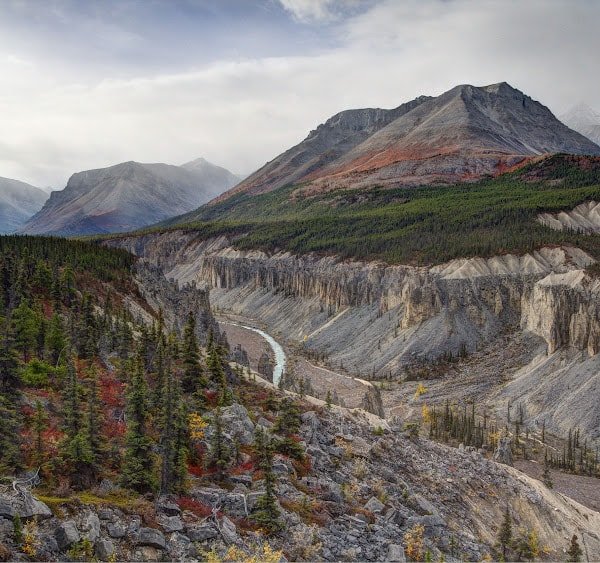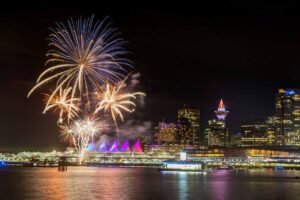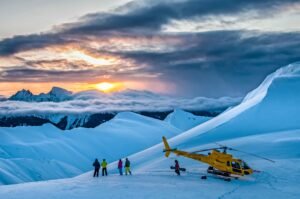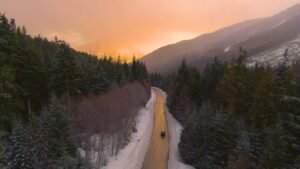Why visit Northern Rocky Mountains Provincial Park? This expansive park in British Columbia offers pristine wilderness, thrilling outdoor activities, and diverse wildlife. In this guide, learn about top hikes, must-see landscapes, and essential travel tips to make the most of your adventure.
Key Takeaways
-
Northern Rocky Mountains Provincial Park is the third largest provincial park in British Columbia, offering a vast wilderness experience accessible by boat, aircraft, or horseback.
-
The park boasts diverse geological features, rich wildlife populations, and numerous outdoor activities, including hiking, fishing, and camping, making it an ideal destination for nature enthusiasts.
-
Fort Nelson serves as a vital gateway to the park, providing essential services and historical insights, while the Muskwa-Kechika Management Area emphasizes the importance of conservation and sustainable practices within the region.
Discovering Northern Rocky Mountains Provincial Park

Northern Rocky Mountains Park, renowned as the third largest provincial park in British Columbia, offers a remote yet accessible wilderness experience. Its vast expanse of 6,657 square kilometers is a sanctuary for adventure enthusiasts and nature lovers alike. Access to this pristine landscape is primarily by boat, aircraft, or horseback, providing a unique sense of seclusion and connection to nature, much like the experiences found in bc parks.
The park is part of the larger Muskwa-Kechika Management Area, which plays a significant role in conservation within the region.
Fort Nelson, a crucial gateway to the park, stands ready to welcome visitors with its rich history and vibrant community. If you want to explore this area, be sure to visit Fort Nelson; the Fort Nelson Heritage Museum, showcasing transportation history through a fascinating collection of antique vehicles, offers a glimpse into the region’s past.
Situated within the Northern Rockies Regional District, the park is part of a broader area celebrated for its rugged beauty and abundant outdoor opportunities.
The Geography and Landscape of Northern Rocky Mountains Provincial Park
The Northern Rocky Mountains Park is a testament to nature’s grandeur, featuring spectacular geological features that captivate every visitor. From the sharp, steep eastern faces of its rugged peaks to the tranquil, glacier-fed rivers that flow through its valleys, the park’s landscape is as diverse as it is breathtaking. Small glaciers nestled within these majestic mountains add to the park’s allure, creating a dynamic environment that changes with the seasons. The northern rocky mountains flow through this stunning landscape, enhancing its beauty.
The park’s elevation range, spanning from valley bottoms to alpine regions, supports a variety of biogeoclimatic zones. These zones foster unique alpine plant communities consist and diverse animal habitats, making the park a haven for biodiversity. Visitors will find themselves immersed in the serene beauty of the alpine tundra biogeoclimatic zones, where nature photography enthusiasts can capture the pristine charm of British Columbia’s wilderness.
Situated in the northern portion of the Rocky Mountains, the park is part of the larger Northern Rockies Regional District. This positioning contributes to the park’s varied climatic conditions and ecosystems, setting it apart from the southern Rocky Mountains. Whether you’re exploring the Peace River Region or marveling at the alpine plant communities, every corner of this largest provincial park offers a new discovery.
Wildlife Encounters in the Park
Northern Rocky Mountains Park is a wildlife enthusiast’s dream, home to a rich array of animal species. Among the park’s residents are significant populations of moose, elk, mountain goats, and the iconic stone sheep, each thriving in their natural habitats. Predators like wolves, grizzly bears, and black bears also roam these lands, supported by the abundant prey.
The park’s numerous wetlands and native grasslands play a crucial role in supporting its diverse wildlife. These ecosystems provide essential habitats for furbearers such as marten, fisher, weasels, and wolverines, contributing to the park’s rich biodiversity. For those interested in aquatic life, the park’s rivers and lakes are teeming with species like lake trout, rainbow trout, and bull trout, making sport fishing a popular activity.
Each season in the park brings unique wildlife viewing opportunities. Spring, in particular, is a fantastic time to visit as animals emerge from hibernation and the park bursts into life. Whether you’re on a guided wildlife tour or exploring on your own, the chance to witness these incredible creatures in their natural environment is an experience you’ll never forget.
Outdoor Adventures Await
For those seeking adventure, Northern Rocky Mountains Park offers a plethora of outdoor activities. Backcountry horseback riding is a unique way to explore the park’s stunning landscapes, allowing visitors to traverse vast wilderness areas and take in the breathtaking views. Whether you’re an experienced rider or a novice, the park’s trails cater to all skill levels, providing an unforgettable journey through nature.
Hunting excursions are another popular activity, offering opportunities to engage with the local ecosystem while adhering to conservation practices. Nature photography is also a significant draw, with the park’s diverse landscapes and wildlife offering endless opportunities for capturing stunning images. From the Wokkpash Recreation Area to the upper canyon, adventure tourism in the park is both thrilling and rewarding.
Designated Trails and Hiking Routes
The designated trails in Northern Rocky Mountains Park cater to hikers of all levels. From easy, well-marked paths to challenging multi-day treks, there’s something for everyone. The Sentinel Range Ridge, noted as the longest and most challenging trail, spans 8.0 km and offers a significant elevation gain, perfect for those seeking a strenuous hike.
For a more extended adventure, the Wokkpash Valley and Machttps://britishcolumbia.com/wp-content/uploads/2020/07/discovery-islands-lodge-1-accommodation-quadra-island-british-columbia-1.jpg Creek Loop Trail provides a challenging multi-day backpacking experience. This trail stretches 82.4 km and typically takes 5 to 7 days to complete, offering hikers a chance to immerse themselves in the park’s remote beauty.
These trails, combined with the park’s spectacular geological features, make hiking in the Northern Rockies an unforgettable experience.
Water Recreation Opportunities
Water enthusiasts will find plenty to enjoy in Northern Rocky Mountains Park. Muncho Lake, with its striking jade green color, is a prime spot for paddling and fishing along its twelve-kilometer stretch. The park also features numerous major rivers like the Tetsa, Chischa, and Muskwa, which are ideal for boating and fishing activities.
Fishing is a popular pastime in the park, with species such as lake trout, rainbow trout, and bull trout inhabiting its waters. The upper and lower Tuchodi Lakes serve as the primary water recreation features within the park, providing ample opportunities for anglers and boaters alike. Upper Tuchodi Lake, in particular, is renowned for its serene environment and excellent fishing spots.
The Kledo Creek Boat Launch offers convenient access for those looking to explore the park’s waterways.
Primitive Campsites and Backcountry Camping
For those seeking a rugged wilderness adventure, Northern Rocky Mountains Park offers various primitive campsites and backcountry camping opportunities. These campsites, typically spaced about a mile apart, provide basic amenities like nearby water sources and, in some cases, fire pits. Camping in the park allows visitors to experience diverse ecosystems, from boreal forests to alpine tundra.
Backcountry camping is a popular choice for adventurers looking to set up camp away from established sites. A Wilderness Pass, costing 8.90 CAD per person per night, is required for backcountry camping, ensuring the preservation of the park’s natural beauty. The Wild Basin area, renowned for its stunning waterfalls, offers various camping spots near lakes for those seeking solitude.
The East Inlet Trail is another excellent option, featuring eight backcountry campsites with incredible views and abundant wildlife opportunities. Whether you’re looking for a remote getaway or a challenging camping experience, Northern Rocky Mountains Park has something to offer every outdoor enthusiast.
The Muskwa-Kechika Management Area
The Muskwa-Kechika Management Area, often referred to as the ‘Serengeti of the North,’ is a vital part of Northern Rocky Mountains Provincial Park. This area is significant for its rich wildlife and natural beauty, playing a crucial role in conservation and resource management at local, regional, national, and international levels. This designation by British Columbia contributes to preserving wilderness and expanding protected zones.
The management area aims to preserve its wilderness characteristics and the diversity of wildlife permanently, while allowing regulated resource development. This balance ensures the protection of the ecosystem while promoting sustainable practices.
The region is abundant in protected areas, including Muncho Lake Provincial Park and Liard River Hot Springs Provincial Park, further enhancing its ecological importance.
Fort Nelson: Gateway to Adventure
Fort Nelson serves as the gateway to Northern Rocky Mountains Provincial Park, offering essential services and a glimpse into the region’s history. The Fort Nelson Heritage Museum, showcasing transportation history with a collection of antique vehicles, is a must-visit for anyone interested in the area’s past. The town’s strategic location along the Alaska Highway makes it a crucial stop for travelers exploring the remote wilderness.
Nearby, the Liard River Hot Springs, the largest natural hot springs in Canada, provide a relaxing retreat surrounded by lush boreal forests. Fort Nelson’s economy, driven by forestry, oil and gas, and a growing tourism sector, supports the local community and enhances the visitor experience.
Exploring the Northern Rockies Regional District
The Northern Rockies Regional District, encompassing Northern Rocky Mountains Park, is a vast area characterized by its mountainous terrain and dense forests. Bordered to the north by the Alaska Highway, the park is adjacent to other significant protected areas like Stone Mountain Provincial Park and Kwadacha Wilderness Provincial Park, forming a contiguous wilderness.
Fort Nelson, the largest community within the district, has a rich history dating back to its establishment as a Hudson Bay Trading Post in 1805. Fort Nelson’s economy, driven by forestry, oil and gas, and a burgeoning tourism sector, supports the region’s development. Regular flights from Central Mountain Air and the northern railhead for CN Rail make Fort Nelson an accessible and essential hub for visitors.
Scenic Spots and Photography Tips
Northern Rocky Mountains Park is a paradise for photographers, offering countless scenic spots to capture nature’s beauty. Even during cloudy weather, the landscape provides abundant photographic opportunities, enhancing the visual quality of timelapse videos and adding dynamic elements to your shots. Utilizing a lens hood can prevent rain droplets on the lens, ensuring clear and crisp photos.
Photographers are encouraged to capture their favorite locations across different seasons and lighting conditions, as these factors can drastically change the appearance of the scene. Including human-made objects in landscape photographs can provide a sense of scale and context, making your images more engaging.
Fall, with its stunning foliage changes, is a particularly picturesque time for photography and quieter exploration.
Seasonal Highlights and Best Times to Visit
The best times to visit Northern Rocky Mountains Park are during May and September when the weather is pleasant, and the crowds are fewer. Recreational activities are most popular during the summer and autumn months, with ideal hiking conditions from mid-June to mid-September. To ensure a smooth trip, it’s advisable to book accommodations at least six months in advance, as the region’s popularity can lead to quick fill-ups.
Each season offers unique highlights, from vibrant spring wildlife to the stunning autumn foliage. Whether you’re hiking, fishing, or simply enjoying the natural beauty, there’s always something special to experience in Northern Rocky Mountains Park.
Conservation Efforts and Ecological Importance
Northern Rocky Mountains Park is a showcase of diverse ecosystems, including old-growth forests of white spruce and numerous wetlands. These wetlands serve critical roles in water filtration, flood control, and providing habitat for numerous species, highlighting their ecological significance. Visitors are encouraged to follow Leave No Trace principles to minimize their impact on this pristine wilderness.
The Muskwa-Kechika Management Area sets a global benchmark for sustainable environmental practices, ensuring the preservation of wilderness, wildlife diversity, and ecosystem health while allowing regulated resource development along the muskwa river. This balance between conservation and economic stability underscores the park’s importance on multiple levels.
Visitor Information and Travel Tips
Practical tips for visiting Northern Rocky Mountains Park include informing someone of your trip itinerary to ensure safety in case of emergencies. Travel insurance is crucial, especially for those participating in outdoor activities in remote areas. A Wilderness Permit is required for backcountry camping, helping to preserve the area’s natural beauty.
Rental vehicles are available in Calgary, providing a convenient base for exploring the Rockies. While public transport options are limited, hitchhiking is possible but not recommended for accessing remote trailheads due to low traffic on gravel roads.
Practicing Leave No Trace principles is essential to minimize environmental impact while enjoying the park’s backcountry camping.
Summary
Northern Rocky Mountains Provincial Park is a treasure trove of natural beauty and outdoor adventure. From its diverse landscapes and rich wildlife to the myriad of activities it offers, the park truly has something for everyone. Whether you’re exploring its scenic trails, engaging in water recreation, or capturing stunning photographs, the park provides endless opportunities for discovery and enjoyment.
As you plan your visit, remember to respect the park’s conservation efforts and follow Leave No Trace principles. By doing so, you’ll help preserve this pristine wilderness for future generations to enjoy. So, pack your bags, embrace the spirit of adventure, and experience the magic of Northern Rocky Mountains Provincial Park.
Frequently Asked Questions
How can I access Northern Rocky Mountains Provincial Park?
To access Northern Rocky Mountains Provincial Park, you will primarily need to use a boat, aircraft, or horseback, given its remote location. This ensures an adventurous entry into the park’s pristine wilderness.
What wildlife can I expect to see in the park?
You can expect to see a diverse array of wildlife in the park, including moose, elk, mountain goats, wolves, and both grizzly and black bears. This rich variety showcases the park’s vibrant ecosystem.
What are the best months to visit the park?
The best months to visit the park are May and September, offering pleasant weather and fewer crowds. This timing enhances the overall experience significantly.
Are there any special permits required for camping in the park?
Yes, a Wilderness Pass is mandatory for backcountry camping, costing 8.90 CAD per person per night.
What activities can I do in Northern Rocky Mountains Provincial Park?
You can enjoy hiking, horseback riding, fishing, hunting excursions, and nature photography in Northern Rocky Mountains Provincial Park. These activities allow you to appreciate the park’s natural beauty while engaging in outdoor adventures.






